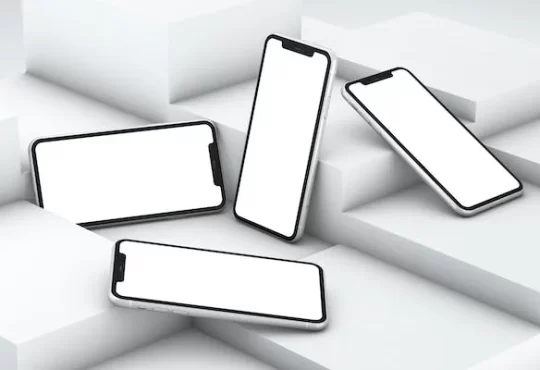There are many different Android phones, ranging from pricey to budget-friendly ones made by Samsung, Google, or OnePlus. But having so many choices can make it hard to decide which one to buy. That’s where we come in to help. We’ve looked into all the best Android phones available.
A great smartphone should have excellent cameras, a battery that lasts a long time, exciting software features, and be able to connect to 5G networks. We thought about all these things when we made our list of the best 5 Android Smartphones, which you can see below.
The Best 5 Android Smartphones
Samsung Galaxy S24 Ultra
Samsung Galaxy S24 Ultra specs: Processor: Qualcomm Snapdragon 8 Gen 3 | Display size: 6.8 inches | Storage options: Up to 1TB | Rear cameras: 200MP main, 12MP ultrawide, 50MP telephoto (5x), 10MP telephoto (3x) | Front camera: 12MP | Battery: 5,000mAh
Samsung’s latest Galaxy S24 line is the first to embrace AI fully, and the S24 Ultra is the fanciest phone you can get. The new Galaxy AI model inside the device adds many cool features, like translating phone calls in real-time, searching for things by circling them on the screen, helping edit photos using AI, and transcribing audio. There’s also a Chat Assist feature to help you choose the right tone for your messages.
Like the S23 Ultra before, the S24 Ultra has a big 6.8-inch AMOLED screen and a robust 5,000mAh battery. Even though the price is higher at $1,299 ($100 more than the S23 Ultra), the upgrades make it worth it. The S24 Ultra is a lightweight but rigid titanium frame that feels lighter in your hand and is easier to grip. It’s also more durable, thanks to Corning’s new Gorilla Armor.
Inside, it has a better Snapdragon 8 Gen 3 chipset for better graphics and AI features, 12GB RAM (up from last year’s 8GB), and a brightness of 2,600 nits, significantly improving over last year’s 1,750. The camera system is also enhanced, with a 50MP telephoto lens with 5x optical zoom for sharper images of faraway things and more precise shots in low light.
Pros:
- Advanced AI features: Real-time translations and AI-assisted photo editing.
- Durable construction: Titanium frame, Gorilla Armor.
- High-performance processor: Snapdragon 8 Gen 3 chipset.
- Large AMOLED display: 6.8 inches.
- I upgraded the camera system to 200MP central and 50MP telephoto (5x zoom).
Cons:
- Higher price: $1,299, $100 more than predecessor.
- Potential complexity with advanced AI.
- Large size: 6.8-inch display.
- Limited availability of certain features.
- Possible compatibility issues with older devices or software.
OnePlus Open
OnePlus Open tech specs: Processor: Qualcomm Snapdragon 8 Gen 2 | Display size: 6.3 (outer) and 7.8 inches (inner) | Storage options: 512GB | Rear cameras: 48MP primary, 48MP ultrawide, 64MP telephoto | Front camera: 32MP (outer), 20MP (inner)
The OnePlus Open strikes an outstanding balance between weight and size. It’s light when folded, like an iPhone, and expands into a thin slate when unfolded. OnePlus makes good use of the 7.8-inch display by offering intuitive multitasking features, like “Open Canvas,” where you can open up to three apps simultaneously, quickly switching between them.
The triple camera setup takes excellent photos and videos, though the casing sticks out more than I’d like. The Open can also take hands-free selfies and group photos because of its foldable design.
OnePlus nails the basics with the Open, including 65W fast charging (with a charger included), 16GB RAM, 512GB storage, and a crease-less inner display. Moreover, it’s priced at $1,699, but OnePlus offers a $200 discount when you trade in any phone, regardless of its condition.
Pros:
- Outstanding balance of weight and size: Light when folded, thin slate when unfolded.
- Intuitive multitasking features: “Open Canvas” allows up to three apps to open simultaneously.
- Triple camera setup: Takes excellent photos and videos.
- Foldable design: Allows for hands-free selfies and group photos.
- The basics include 65W fast charging, 16GB RAM, 512GB storage, and a crease-less inner display.
- Discount offer: Priced at $1,699, with a $200 discount for trading in any phone.
Cons:
- The camera casing sticks out more than desired.
- It may be expensive for some users at $1,699.
Google Pixel 8 Pro
Google Pixel 8 Pro tech specs: Processor: Google Tensor G3 | Display size: 6.7 inches | Storage options: 128GB/256GB/512GB/1TB | Rear cameras: 50MP primary, 48MP ultrawide, 48MP telephoto | Front camera: 10.8 MP
The Pixel 8 Pro isn’t Google’s top-of-the-line flagship anymore; that title goes to the $1,799 Pixel Fold. But it’s still Google’s most refined and tested device yet. The 6.7-inch model now has a more even curved glass-to-aluminum body and runs on an updated Google Tensor G3 chip. With the new processor, the Pixel 7 Pro gets better efficiency and performance, as well as a range of AI features like context-aware call screening responses, text summarization and translation, and simultaneous voice-to-text input with multiple languages.
Google focuses on “accessible creativity,” giving their phone a unique touch that many other smartphones lack. The Pixel 8 Pro’s triple camera system and Google’s computational expertise put it ahead of the competition. Its camera captures natural-colored photos and videos and excels in low-light conditions with HDR enhancement.
Moreover, suppose you’re not happy with your shots. In that case, additional AI features like Best Take, Audio Magic Eraser, and Magic Editor let you adjust subjects’ faces, remove background noise from videos, and change lighting and ambiance in photos after taking them.
Pros:
- Refined device: Google’s most refined and tested device.
- Improved design: Features a more curved glass-to-aluminum body.
- Updated processor: Runs on an updated Google Tensor G3 chip for better efficiency and performance.
- Range of AI features: Includes context-aware Call Screening, text summarization, translation, and simultaneous voice-to-text input.
- Unique touch: Focuses on “accessible creativity,” offering a fantastic experience.
- Excellent camera system: Captures natural-colored photos and excels in low-light conditions with HDR enhancement.
- Additional AI features: Best Take, Audio Magic Eraser, and Magic Editor for adjustments after taking photos.
Cons:
- Not the top flagship: The Pixel Fold holds that title, priced at $1,799.
- Possible high cost: The Pixel 8 Pro’s price may be higher than that of other smartphones.
Motorola Razr Plus
Motorola Razr Plus tech specs: Processor: Qualcomm Snapdragon 8+ Gen 1 | Display size: 3.6 inches external, 6.9 inches internal | Storage options: 256GB | Rear cameras: 12MP main, 13MP ultra-wide | Front camera: 32MP
Phones are getting faster and more extensive, but the Motorola Razr Plus stands out among the 2023 smartphones. It’s a clamshell-style foldable phone, changing from a small 3.6-inch display to a larger 6.9-inch size when needed. When folded, it’s as small as a card slot wallet.
Despite its small size, the Motorola Razr Plus has many features and works well. It runs on an older Snapdragon 8+ Gen 1 processor but can still run apps like Instagram, WhatsApp, YouTube, and games. With the big external display, you can use the same apps without opening the phone. It feels like having two phones in one.
In my review, I said, “Razr Plus is Motorola’s return to form, modernizing a classic flip phone into one of today’s best foldables.” While the Samsung Galaxy Z Fold 4 is the best, the Razr Plus is an excellent choice for a dual-screen phone for less money.
Pros:
- Compact design: Folds to a 3.6-inch size, like a card slot wallet.
- Dual-screen functionality: Expands to a 6.9-inch display when needed.
- Variety of features: Despite its size, the Razr Plus offers many features.
- External display convenience: Large external display runs apps without opening the phone.
- Processor capability: Runs apps like Instagram, WhatsApp, YouTube, and games.
- Competitive pricing: Offers a dual-screen experience for less than the Samsung Galaxy Z Fold 4.
Cons:
- Processor age: Uses an older Snapdragon 8+ Gen 1 processor.
- Limited storage: Comes with fixed 256GB storage.
- Camera setup: The primary camera is 12MP, which is lower than that of some competitors.
- Small external display: A 3.6-inch display may feel limiting.
- It is not a top-tier foldable: It doesn’t exceed the Samsung Galaxy Z Fold 4 in performance.
Nothing Phone 2
Nothing Phone 2 tech specs: Processor: Qualcomm Snapdragon 8+ Gen 1 | Display size: 6.7 inches | Storage options: 128GB/256GB/512GB | Rear cameras: 50MP primary, 50MP ultrawide | Front camera: 32MP
Nothing has become a famous Android maker in recent years, known for its flashy transparent design that appeals to retro-tech enthusiasts. It’s one of the few new players in the smartphone market, entering at a time when others are leaving.
The latest flagship from Nothing, the Nothing Phone 2, lives up to the hype. It runs on a Qualcomm Snapdragon 8+, enough for Nothing’s minimalist software experience.
The standout feature of the Phone 2 is the Glyph Interface, which has LED strips on the back that blink in unique patterns for alerts and notifications. It’s a clever use of the transparent back panel, encouraging users to look at their screens less.
Priced at $700, the Nothing Phone 2 is cheaper than most flagships but offers a charming smartphone package that design enthusiasts will love.
Pros:
- Powerful processor: Qualcomm Snapdragon 8+ Gen 1 ensures smooth performance.
- Ample storage: 128GB, 256GB, and 512GB options.
- Impressive cameras: 50MP primary camera, ultrawide rear camera, and a 32MP front camera.
- Unique design: Transparent look with LED strips on the back for notifications.
- Minimalist software: Focuses on digital well-being for a clean user experience.
- Competitive price: Priced at $700, offering flagship features at a lower cost.
Cons:
- Initially, with limited availability.
- Potential durability concerns with the transparent design.
- Brand recognition may be lower than that of established manufacturers.
Finding the Right Android Phone for Your Needs
Android phones offer various choices, ranging from Samsung’s sleek designs to Google’s innovative features and OnePlus’s compelling offerings. Making the right decision can be daunting, but our comprehensive review of the best Android phones aims to simplify your selection process. Each phone we’ve examined has unique advantages and drawbacks, from top-tier performance and cutting-edge camera capabilities to sleek designs and budget-friendly options. Whether you prioritize advanced technology, seamless multitasking, or affordability, our review provides insights to help you find the perfect Android phone to suit your needs.





